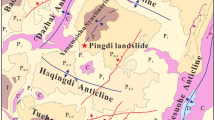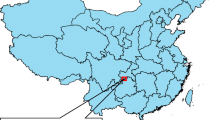Abstract
The 2000 Yigong landslide was one of the most catastrophic landslides worldwide, resulting in huge casualties and property losses. The dynamic process of the Yigong landslide was very complicated, especially for the initiation and entrainment mechanism during the landslide movement process. The topography, geological condition, traces left by the landslide, and distribution characteristics of the landslide deposits were determined by field investigations, combined with several years of monitoring the temperature and rainfall data in this region. The initiation mechanism of the Yigong landslide is presented. The main reasons for the landslide initiation are as follows: the strength reduction of rock masses (especially for the weak structural surface), the impact from years of freeze-thaw cycles, the superposition of glacier melting and heavy rainfall on the slope, and a slope that was almost at the limit state before the landslide. Laboratory tests and physical modeling experiments were carried out to study the entrainment process of this landslide. Combined with the topographic survey data and theoretical analyses, the entrainment mechanism during the movement process of the Yigong landslide is presented. The old landslide deposits on the lower slope collided with and were scraped by the high-speed debris avalanche, which resulted in the volume amplification of the landslide. The existence of water plays a key role during the landslide initiation and movement processes.

















Similar content being viewed by others
References
Acharya G, Cochrane T, Davies T, Bowman E (2011) Quantifying and modeling post-failure sediment yields from laboratory-scale soil erosion and shallow landslide experiments with silty loess. Geomorphology 129:49–58
Angeli MG, Bunma J, Gasparetto P, Pasuto A (1998) A combined hillslope hydrology/stability model for low-gradient clay slopes in the Italian Dolomites. Eng Geol 49:1–13
Barth NC (2014) The Cascade rock avalanche: implications of a very large Alpine Fault-triggered failure, New Zealand. Landslides 11:327–341
Bayard D, Stähli M, Parriaux A, Flühler H (2005) The influence of seasonally frozen soil on the snowmelt runoff at two Alpine sites in southern Switzerland. J Hydrol 309:66–84
Borgatti L, Soldati M (2010) Landslides as a geomorphological proxy for climate change: a record from the Dolomites (northern Italy). Geomorphology 120:56–64
Cepeda J, Chávez JA, Martínez CC (2010) Procedure for the selection of runout model parameters from landslide back-analyses: application to the Metropolitan Area of San Salvador, El Salvador. Landslides 7:105–116
Crosta GB, Imposimato S, Roddeman D, Chiesa S, Moia (2005) Small fast-moving flow-like landslides in volcanic deposits: the 2001 Las Colinas Landslide (El Salvador). Eng Geol 79:185–214
Crosta GB, Imposimato S, Roddeman D (2009) Numerical modelling of entrainment/deposition in rock and debris-avalanches. Eng Geol 109:135–145
Dai FC, Tu XB, Xu C, Gong QM, Yao X (2011) Rock avalanches triggered by oblique-thrusting during the 12 May 2008 Ms 8.0 Wenchuan earthquake, China. Geomorphology 132:300–318
Draebing D, Krautblatter M, Diakau R (2014) Interaction of thermal and mechanical processes in steep permafrost rock walls: a conceptual approach. Geomorphology 226:226–235
Dufresne A (2012) Granular flow experiments on the interaction with stationary runout path materials and comparison to rock avalanche events. Earth Surf Process Landf 37:1527–1541
Dufresne A, Davies TR (2009) Longitudinal ridges in mass movement deposits. Geomorphology 105:171–181
Dufresne A, Davies TR, McSaveney MJ (2010) Influence of runout-path material on emplacement of the Round Top rock avalanche, New Zealand. Earth Surf Process Landf 35:190–201
Evans SG, Hungr O, Clague JJ (2001) Dynamics of the 1984 rock avalanche and associated distal debris flow on Mount Cayley, British Columbia, Canada; implications for landslide hazard assessment on dissected volcanoes. Eng Geol 61:29–51
Hsü KJ (1978) Albert Heim: observations on landslides. In: Voight B (ed) Rockslides and avalanches, vol 1. Elsevier, Amsterdam, pp 70–93
Hu M, Chen Q, Wang F (2009a) Experimental study on formation of Yigong long-distance high-speed landslide. Chin J Rock Mech Eng 28:138–143 (in Chinese)
Hu M, Wang F, Chen Q (2009b) Formation of tremendous Yigong landslide based on high-speed shear test. Chin J Geotech Eng 31:1602–1606 (in Chinese)
Huang RQ, Li WL (2009) Analysis of the geo-hazards triggered by the 12 May 2008 Wenchuan earthquake, China. Bull Eng Geol Environ 68:363–371
Hungr O, Corominas J, Eberhardt E (2005) Estimating landslide motion mechanism, travel distance and velocity. In: Proceedings of the International Conference on Landslide Risk Management, pp. 99–128
Kerle N, van Wyk de Vries B (2001) The 1998 debris avalanche at Casita volcano, Nicaragua—investigation of structural deformation as the cause of slope instability using remote sensing. J Volcanol Geotherm Res 105:49–63
Korup O, Clague JJ, Hermanns RL, Hewitt K, Strom A, Weidinger JT (2007) Giant landslides, topography, and erosion. Earth Planet Sci Lett 261:578–589
Krautblatter M, Funk D, Günzel FK (2013) Why permafrost rocks become unstable: a rock–ice-mechanical model in time and space. Earth Surf Process Landf 38:876–887
Kuo Y, Tsai Y, Chen Y, Shieh C, Miyamoto K, Itoh T (2013) Movement of deep-seated rainfall-induced landslide at Hsiaolin Village during Typhoon Morakot. Landslides 10:191–202
Lai Y, Yang Y, Chang X, Li S (2010) Strength criterion and elastoplastic constitutive model of frozen silt in generalized plastic mechanics. Int J Plast 26:1461–1484
Legros F (2002) The mobility of long-runout landslides. Eng Geol 63:301–331
Liu W (2002) Study on the characteristics of huge scale-super high speed-long distance landslide chain in Yigong, Tibet. Chin J Geol Hazard Control 13:9–18 (in Chinese)
Lo C, Lin M, Tang C, Hu J (2011) A kinematic model of the Hsiaolin landslide calibrated to the morphology of the landslide deposit. Eng Geol 123:22–39
Lv J, Wang Z, Zhou C (2003) Discussion on the occurrence of Yigong landslide in Tibet. Earth Sci J China Univ Geosci 28:107–110 (in Chinese)
Ma W, Wu Z, Zhang L, Chang X (1999) Analyses of process on the strength decrease in frozen soils under high confining pressures. Cold Reg Sci Technol 29:1–7
Mather AE, Hartley AJ, Griffiths (2014) The giant coastal landslides of Northern Chile: tectonic and climate interactions on a classic convergent plate margin. Earth Planet Sci Lett 388:249–256
McDougall S, Hungr O (2005) Dynamic modelling of entrainment in rapid landslides. Can Geotech J 42:1437–1448
Niemi NA, Oskin M, Burbank DW, Heimsath AM, Gabet EJ (2005) Effects of bedrock landslides on cosmogenically determined erosion rates. Earth Planet Sci Lett 237:480–498
Pudasaini SP, Miller SA (2013) The hypermobility of huge landslides and avalanches. Eng Geol 157:124–132
Sassa K (2000) Mechanism of flows in granular soils. In: Proceedings of GeoEng2000, Melbourne, 19–24 November, vol. 1. Technomic Publishing Company, USA, pp 1671–1702
Scott KM, Vallance JW, Kerle N, Macías JL, Strauch W, Devoli G (2005) Catastrophic precipitation-triggered lahar at Casita volcano, Nicaragua: occurrence, bulking and transformation. Earth Surf Process Landf 30:59–79
Shang Y, Yang Z, Li L, Liu D, Liao Q, Wang Y (2003) A super-large landslide in Tibet in 2000: background, occurrence, disaster, and origin. Geomorphology 54:225–243
Shang Y, Park H, Yang Z, Yang J (2005) Distribution of landslides adjacent to the northern side of the Yarlu Tsangpo Grand Canyon in Tibet, China. Environ Geol 48:721–741
Shea T, van Wyk de Vries B (2008) Structural analysis and analogue modelling of the kinetics and dynamics of rockslide avalanches. Geosphere 4:657–686
Staron L (2008) Mobility of long-runout rock flows: a discrete numerical investigation. Geophys J Int 172:455–463
Tang CL, Hu JC, Lin ML, Angelier J, Lu CY, Chan YC, Chu HT (2009) The Tsaoling landslide triggered by the Chi-Chi earthquake, Taiwan: insights from a discrete element simulation. Eng Geol 106:1–19
Tang H, Jia G, Hu X, Li D, Xiong C (2010) Characteristics of landslides induced by the great Wenchuan earthquake. J Earth Sci 21:104–113
Tsou C, Feng Z, Chigira M (2011) Catastrophic landslide induced by Typhoon Morakot, Shiaolin, Taiwan. Geomorphology 127:166–178
Van Wyk de Vries B, Self S, Francis PW, Keszthelyi L (2001) A gravitational spreading origin for the Socompa debris avalanche. J Volcanol Geotherm Res 105:225–247
Wang G, Sassa K, Fukuoka H (2003) Downslope volume enlargement of a debris slide–debris flow in the 1999 Hiroshima, Japan, rainstorm. Eng Geol 69:309–330
Wang G, Huang R, Chigira M, Wu X, Lourenҫo SDN (2013) Landslide amplification by liquefaction of runout-path material after the 2008 Wenchuan (M 8.0) earthquake, China. Earth Surf Process Landf 38:265–274
Weidinger JT, Korup O, Munack H, Altenberger U, Dunning SA, Tippelt G, Lottermoser W (2014) Giant rock slides from the inside. Earth Planet Sci Lett 389:62–73
Xu Q, Shang Y, van Asch T, Wang S, Zhang Z, Dong X (2012) Observations from the large, rapid Yigong rock slide—debris avalanche, southeast Tibet. Can Geotech J 49:589–606
Yin Y (2011) Recent catastrophic landslides and mitigation in China. J Rock Mech Geotech Eng 3:10–18
Yin Y, Xing A (2012) Aerodynamic modeling of the Yigong gigantic rock slide-debris avalanche, Tibet, China. Bull Eng Geol Environ 71:149–160
Yin Y, Zheng W, Li X, Sun P, Li B (2011) Catastrophic landslides associated with the M8.0 Wenchuan earthquake. Bull Eng Geol Environ 70:15–32
Zhou JW, Xu WY, Yang XG, Shi C, Yang ZH (2010) The 28 October 1996 landslide and analysis of the stability of the current Huashiban slope at the Liangjiaren Hydropower Station, Southwest China. Eng Geol 114:45–56
Zhou JW, Cui P, Fang H (2013a) Dynamic process analysis for the formation of Yangjiagou landslide-dammed lake triggered by the Wenchuan earthquake, China. Landslides 10:331–342
Zhou JW, Cui P, Yang XG (2013b) Dynamic process analysis for the initiation and movement of the Donghekou landslide-debris flow triggered by the Wenchuan earthquake. J Asian Earth Sci 76:70–84
Zhu P, Wang C, Tang B (2000) The deposition characteristic of supper debris flow in Tibet. J Mt Sci 18:453–456 (in Chinese)
Zhu Z, Ling X, Wang Z, Lu Q, Chen S, Zou Z, Guo Z (2011) Experimental investigation of the dynamic behavior of frozen clay from the Beiluhe subgrade along the QTR. Cold Reg Sci Technol 69:91–97
Acknowledgments
We gratefully acknowledge the support of the National Natural Science Foundation of China (41472272, 41030742, and 41102194) and the Science Foundation for Excellent Youth Scholars of Sichuan University (2013SCU04A07). Dr. Gong-dan Zhou and Dr. Zhi-man Su provided valuable discussion on the initiation mechanism of the Yigong landslide. Critical comments by the reviewers greatly improved the initial manuscript.
Author information
Authors and Affiliations
Corresponding author
Rights and permissions
About this article
Cite this article
Zhou, Jw., Cui, P. & Hao, Mh. Comprehensive analyses of the initiation and entrainment processes of the 2000 Yigong catastrophic landslide in Tibet, China. Landslides 13, 39–54 (2016). https://doi.org/10.1007/s10346-014-0553-2
Received:
Accepted:
Published:
Issue Date:
DOI: https://doi.org/10.1007/s10346-014-0553-2




